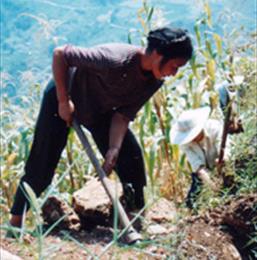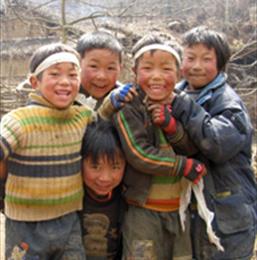Zhongpu Village, Ganluo 2001-2004
Lianghe Township is situated in Ganluo County, about 27 km from the county seat. It lies at an altitude between 1700-2200m above sea level. According to 2001 statistics, it is made up of 8 villages, 19 hamlets. The total number of households is 595 and the population is 2453. There is in total 6000 mu of agricultural land, or 2.5 mu per person. Average amount of grain per person is 400 kg.
The other village in Lianghe Township where DORS works is Zhongpu Village. While both Baikun and Zhongpu villages are situated high in the mountains, Zhongpu is lower down from the mountain top at an average height of 1850m. It is 20-25 minute drive from Lianghe township government. The road from Lianghe township government to the village is a rough unsurfaced road, which is steep and rocky.
Zhongpu village has 2 hamlets and a total population of 464 people. They are predominately of Yi minority and are noticeably poor. Average household income in 2001 was 1375 RMB. Income is generated by agriculture and animal husbandry. Non-monetary trading also takes place in the form of exchanging potatoes/corn for grains in the form of rice or noodles, or animal feed. Average household expenditure in households surveyed (2001) was 2018 RMB – considerably higher than income. Villagers cope by borrowing money from friends or family. There is a continuing trend for households to move out of the village once they can afford to move.
DORS’ first visit to Zhongpu Village was made on 28th May 2001 and an integrated community development programme, funded by Kadoorie Charitable Foundation, was started soon after.
Drinking and Irrigation Water Supply
Initial research on Zhongpu village showed access to safe drinking water to be “of primary importance”, as villagers were having to make many trips to the nearest (open) water source (over an hour away during the dry winter season). The water source was unsanitary because many people and animals visited it every day. In meetings villagers stressed that access to safe drinking water was their major concern.
The Water Conservatory Bureau had previously implemented a water supply system in 1980 connecting the village to the nearest source 3km away. Drinking water was however unavailable because existing pipes had deteriorated, and the old water tank was leaking and was badly situated, being lower than some of the houses.
The final design was for a separate system for each of the two hamlets. Each system having one large storage tank, and hamlet 1 had provision for one break-pressure tank. The system was PVC piping for the main pipes and metal pipes to the household, a source tank of 1 cubic metre, and UPVC pipes for the main pipes to the reservoir tanks. The design included a total 7975m of piping. Pipes were to be connected to each household.
The water supply was constructed over a 10-month period. Initially the village planned to finish building all the tanks before winter. For various reasons this was not possible, and construction began in January. Therefore, the main part of project funding was disbursed in January 2002. Usually funding is disbursed in two parts, the first part for the tank materials and the second part for the piping. As there were some material shortages, and the villagers were unable to make a further contribution, after careful consideration DORS agreed to provide some extra materials, totalling 1,959 RMB. Construction was completed by July 2002.
During the design phase it was agreed that the villagers would contribute 15 RMB per household, to pay for valves, taps, and for a technician to help build the project. Villagers also contributed labour in building the water project, as well as carrying cement and sand to save on transport costs. The Water Conservancy Bureau provided the design free of charge, and it was amended with assistance from Hanyuan WCB, also free of charge.
DORS contribution was 34,954.86 RMB, or GBP 2,687.83, of the total project funds.
The water project supplies 75 households, giving a total of 373 people access to drinking water. The water is safer than the water fetched from the old open source, as it is collected in a source tank, which allows settlement and is not exposed to livestock. Villagers will thus have safer water for drinking, as well as a more abundant supply, which will allow for more convenient washing and food preparation. Considerable time and labour will be saved, as villagers will not have to walk long distances, several times a day, to fetch water. This will have economic benefits – allowing villagers more time to engage in agricultural production or other activities. Women also provide much of the agricultural labour force, and will benefit as women and children are the primary water carriers in the winter months. Improvement of conditions may help stem out-migration from the village. This would benefit the economy, as out-migrants are usually of working age.
The drinking water project was begun in Oct 2001 and was completed in July 2002. The cost per person was 93.7 RMB or £7.80. A total of 12 households were interviewed, out of a total of 35 households. The overall impression was satisfaction both with the way the water project was carried out and with the water project itself. There had been some problems with pipes bursting in the winter. The local maintenance person has already fixed these.
Electricity Supply
The electricity project was undertaken at the request of the villages, to replace an aged electricity system, built in 1974, which had fallen into disrepair. The former was owned and maintained by the villagers. However, because the generator was very old, it leaked oil and sparked. The wires needed replacing, and the old wooden telephone poles were rotten.
The Ganluo Water Conservancy Bureau drew plans for the proposed electricity project and after consulting with the electricity company, estimated costs were drawn up. DORS staff approached some local officials, including the County Leader (Luo Hua), who agreed to see if it would be possible to include the two villages onto the Nongwang Gaizao scheme (a government-sponsored scheme to connect rural villages onto the central electricity grid). Ganluo County approved DORS’ request for the villages to be included in the Nongwang Gaizao scheme, which resulted in large savings of funds. The scheme provided most of the funds, but required a total contribution of RMB 130 from each household to be connected. DORS helped the villagers to cover the cost by agreeing to pay RMB 100 of that sum. The households then contributed RMB 30 each.
72 households (302 people) in Zhongpu village benefited from this project. The original contract with the Nongwang Gaizao Bureau was for 12,700 yuan. The Nongwang Gaizao contributed 225,950 RMB to connect Zhongpu Village to the electricity grid. DORS’ successful application for the villages to be included in the Nongwang Gaizao scheme saved a lot of funds that were previously planned to improve the electricity in these village, which DORS was able to use in other areas of the Kadoorie integrated development project.
Delivering electricity poles
The new electricity supply project began in August 2002 and was completed in November - December 2002, at a total cost of RMB 23262, or GBP 1938.50, including the villagers’ contributions. Total DORS contribution for both Zhongpu and Baikun villages amounted to RMB 16342, or GBP 1361.83.
Animal Sty Improvements
Initial studies identified animal husbandry as being a significant source of yearly income for many villagers in Zhongpu. DORS also noted that villagers were particularly interested in developing animal husbandry projects, particularly with goats, and would like to expand the number of current livestock.
While many villagers had sties and pens, these were in bad condition and in need of repair. Some villagers also lacked adequate sties to separate their various animals. Such an environment made it difficult to raise quality, healthy livestock.
Villagers came up with the idea of a project to support animal husbandry. DORS mentioned that animal husbandry projects are usually supported in association with complementary projects such as improving animal sties and providing skills training. Together with villagers, DORS decided that repairing and building sties was a suitable way to address problems identified in the village.
DORS carried out a survey to assess those households considered as particularly poor, poor, average and wealthy. Priority was given to poor and particularly poor households, with other villagers also able to participate in the project. Materials were allocated according to need, such that households assessed as particularly poor and poor were provided with more materials and average and wealthy households were provided with some materials but asked to provide additional materials themselves.
Mr. Bai discussing with villager
A contract was signed by village leaders and the DORS technical officer on 5 May 2003.
In this project, we attempted to facilitate a participatory process in which villagers themselves decided on the best process to meet project aims. Villagers played an important role in deciding how to repair sties, what materials to use and what design to use. They also played a major role in building the sties/pens themselves.
The main stages of project implementation are outlined below:
Stage 1: February - April 2003
Project planning stage
DORS conducted a study to determine particularly poor, poor, average and wealthy households. All households were permitted to participate in the project.
A meeting was organized to discuss with villagers their views and needs for sty/pen repairs and constructions.
Stage 2: May 2003
Materials and financial planning
Villagers and DORS discussed what could be achieved with available funds. Based on village views, plans were made to decide: what materials were required; who would provide what; how sties would be constructed etc.
A participant information form was prepared, listing the names of participants and materials to be provided.
A contract was also prepared and signed by both DORS and village representatives.
Stage 3: Preparation of materials: From June 2003
Participants prepared additional materials required to construct sties/pens, such as stones, sand, poles and rafters. After preparing materials they notified the Village Cadre, who arranged for tiles and/or cement to be distributed.
DORS visited to check on project progress
Stage 4: Construct sty/pen: From June 2003
Households repair and build sties. In most cases work was achieved through villagers assisting each other. Households would provide food, alcohol and cigarettes to those villagers who help with labour.
DORS visited to check on project progress and follow up on problems
Stage 5: Final evaluation: April 2004
DORS visited villages during project implementation to monitor progress. Towards the end of the project, an evaluation visit was organized in which all participating households were visited. DORS recorded information on whether or not sties were completed and what materials were provided. The condition of sties was inspected. Where sties were not completed, DORS consulted participants on reasons for this, attempted to address problems and facilitate processes to enable sties to be completed as soon as possible.
Most of these project components were funded by Kadoorie Foundation 2001-2004.


